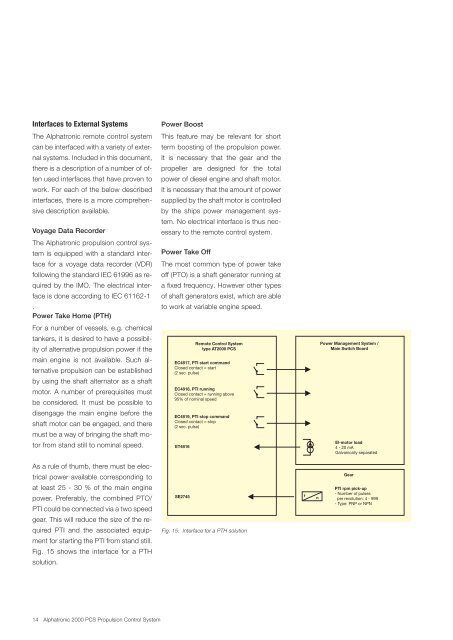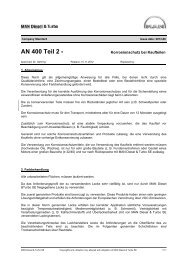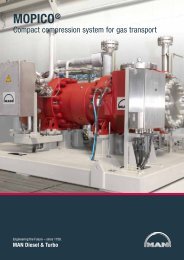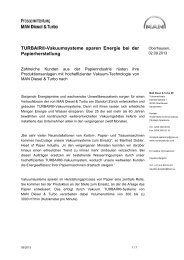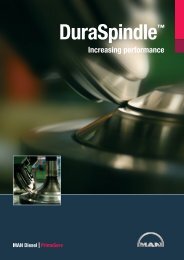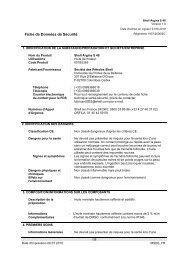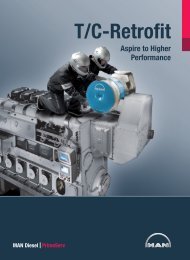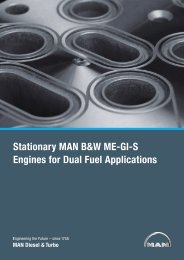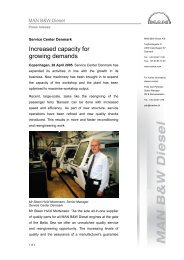Alphatronic 2000 PCS - MAN Diesel & Turbo
Alphatronic 2000 PCS - MAN Diesel & Turbo
Alphatronic 2000 PCS - MAN Diesel & Turbo
Create successful ePaper yourself
Turn your PDF publications into a flip-book with our unique Google optimized e-Paper software.
Interfaces to External Systems<br />
The <strong>Alphatronic</strong> remote control system<br />
can be interfaced with a variety of exter-<br />
nal systems. Included in this document,<br />
there is a description of a number of of-<br />
ten used interfaces that have proven to<br />
work. For each of the below described<br />
interfaces, there is a more comprehen-<br />
sive description available.<br />
Voyage Data Recorder<br />
The <strong>Alphatronic</strong> propulsion control sys-<br />
tem is equipped with a standard inter-<br />
face for a voyage data recorder (VDR)<br />
following the standard IEC 61996 as re-<br />
quired by the IMO. The electrical inter-<br />
face is done according to IEC 61162-1<br />
.<br />
Power Take Home (PTH)<br />
For a number of vessels, e.g. chemical<br />
tankers, it is desired to have a possibil-<br />
ity of alternative propulsion power if the<br />
main engine is not available. Such al-<br />
ternative propulsion can be established<br />
by using the shaft alternator as a shaft<br />
motor. A number of prerequisites must<br />
be considered. It must be possible to<br />
disengage the main engine before the<br />
shaft motor can be engaged, and there<br />
must be a way of bringing the shaft mo-<br />
tor from stand still to nominal speed.<br />
As a rule of thumb, there must be elec-<br />
trical power available corresponding to<br />
at least 25 - 30 % of the main engine<br />
power. Preferably, the combined PTO/<br />
PTI could be connected via a two speed<br />
gear. This will reduce the size of the re-<br />
quired PTI and the associated equip-<br />
ment for starting the PTI from stand still.<br />
Fig. 15 shows the interface for a PTH<br />
solution.<br />
14 <strong>Alphatronic</strong> <strong>2000</strong> <strong>PCS</strong> Propulsion Control System<br />
Power Boost<br />
This feature may be relevant for short<br />
term boosting of the propulsion power.<br />
It is necessary that the gear and the<br />
propeller are designed for the total<br />
power of diesel engine and shaft motor.<br />
It is necessary that the amount of power<br />
supplied by the shaft motor is controlled<br />
by the ships power management sys-<br />
tem. No electrical interface is thus nec-<br />
essary to the remote control system.<br />
Power Take Off<br />
The most common type of power take<br />
off (PTO) is a shaft generator running at<br />
a fixed frequency. However other types<br />
of shaft generators exist, which are able<br />
to work at variable engine speed.<br />
ET4816<br />
Remote Control System<br />
type AT<strong>2000</strong> <strong>PCS</strong><br />
EC4817, PTI start command<br />
Closed contact = start<br />
(2 sec. pulse)<br />
EC4818, PTI running<br />
Closed contact = running above<br />
95% of nominal speed<br />
EC4819, PTI stop command<br />
Closed contact = stop<br />
(2 sec. pulse)<br />
SE2745<br />
Fig. 15: Interface for a PTH solution<br />
f<br />
n<br />
Power Management System /<br />
Main Switch Board<br />
El-motor load<br />
4 - 20 mA<br />
Galvanically separated<br />
Gear<br />
PTI rpm pick-up<br />
- Number of pulses<br />
per revolution: 4 - 999<br />
- Type: PNP or NPN


